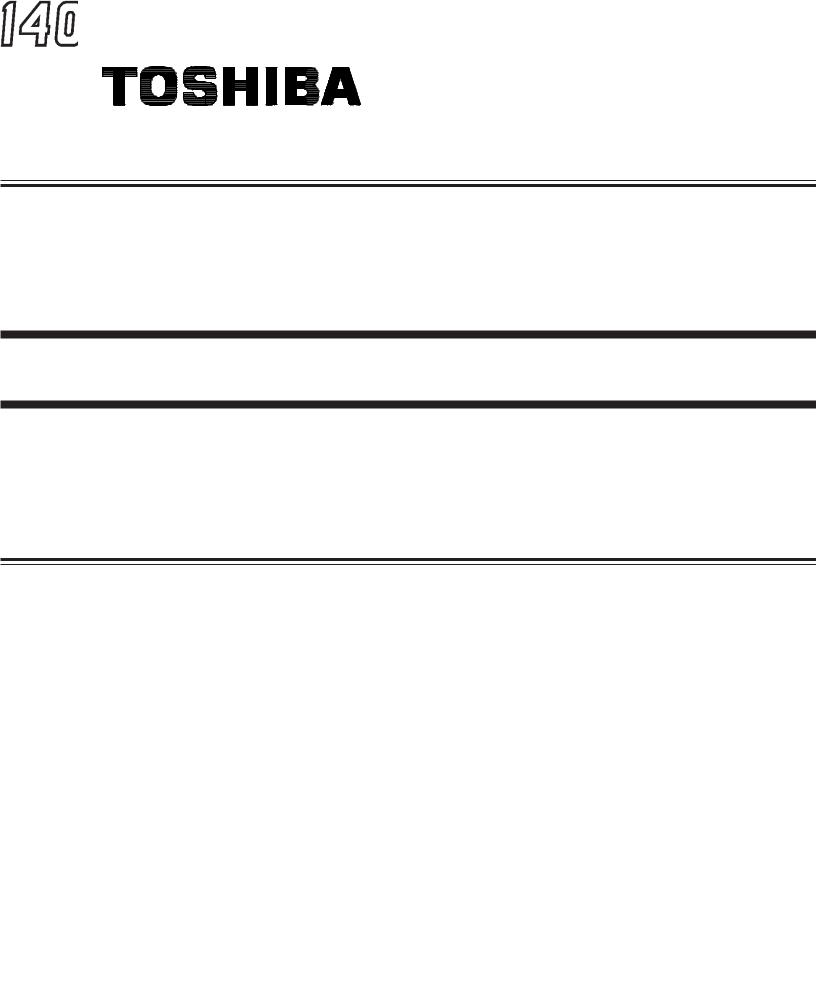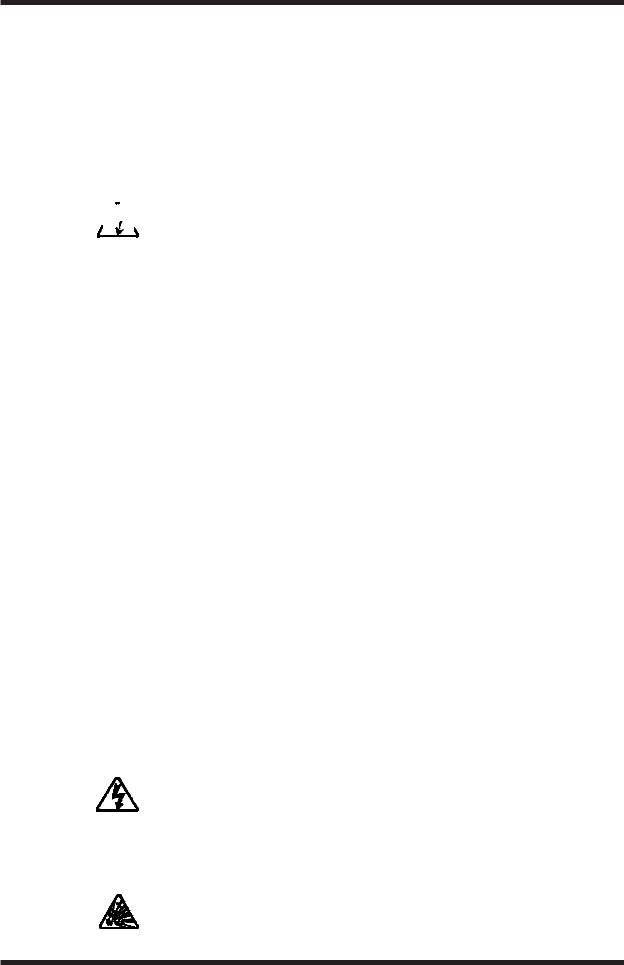TOSHIBA 1400XL PLUS User Manual

TOSHIBA
Battery Cabinet System
SINGLE PHASE - 2.4/3.6/6.0/8.0 KVA PLUS
MANUFACTURED IN THE U.S.A.
OPERATION MANUAL
October, 1996
Part # 43241-002

TOSHIBA

TOSHIBA
NOTE
These instructions are not intended to cover all of the details or variations in equipment, nor to provide for every possible contingency to be met in connection with installation, operation, or maintenance. This manual may change without notice. Contact your local Toshiba sales office to verify that this is the latest revision. Should further information be desired or should particular problems arise which are not covered sufficiently for the purchaser's purposes, the matter should be referred to the local Toshiba sales office.
The contents of this instruction manual shall not become a part of or modify any prior or existing agreement, commitment, or relationship. The sales contract contains the entire obligation of Toshiba International Corporation's UPS Division. The warranty contained in the contract between the parties is the sole warranty of Toshiba International Corporation's UPS Division and any statements contained herein do not create new warranties or modify the existing warranty.
UNINTERRUPTIBLE POWER SUPPLY
Please complete the enclosed Extended Warranty Card and return it by prepaid mail to Toshiba. This activates the extended warranty. If additional information or technical assistance is required call Toshiba's marketing department toll free at 1-800-231-1412 or write to: Toshiba International Corporation, 13131 W. Little York Road, Houston, TX 77041-9990.
Please complete the following information for your records and to remain within this equipment manual:
Model Number:
Serial Number:
Date of Installation:
Inspected By:
i

TOSHIBA
GENERAL SAFETY INSTRUCTIONS
Warnings in this manual appear in any of four ways:
1)Danger- The danger symbol is a lightning bolt mark enclosed in a triangle which precedes the 3/16" high letters spelling the word "DANGER". The danger symbol is used to indicate imminently hazardous situations, locations, and conditions which, if not avoided, WILL result in death, serious injury, and/or severe property damage.
 DANGER
DANGER
2)Warning - The warning symbol is an exclamation mark enclosed in a triangle which precedes the 3/16" high letters spelling the word "WARNING". The warning symbol is used to indicate potentially hazardous situations and conditions which, if not avoided COULD result in serious injury or death. Severe property damage COULD also occur.
 WARNING
WARNING
3)Caution - The caution symbol is an exclamation mark enclosed in a triangle which precedes the 3/16" high letters spelling the word "CAUTION". The caution symbol is used to indicate potentially hazardous situations and conditions which, if not avoided may result in injury. Equipment damage may also occur.
 CAUTION
CAUTION
4)Attention warnings - The attention warning symbol is an exclamation mark enclosed in a triangle which precedes the 3/16" high letters spelling the word "ATTENTION". The Attention warning symbol is used to indicate situations and conditions that can cause operator injury and/or equipment damage:
 ATTENTION
ATTENTION
Other warning symbols may appear along with the Danger and Caution symbol and are used to specify special hazards. These warnings describe particular areas where special care and/or procedures are required in order to prevent serious injury and possible death:
1)Electrical warnings - The electrical warning symbol is a lighting bolt mark enclosed in a triangle. The Electrical warning symbol is used to indicate high voltage locations and conditions that may cause serious injury or death if the proper precautions are not observed:
2)Explosion warnings - The explosion warning symbol is an explosion mark enclosed in a triangle. The Explosion warning symbol is used to indicate locations and conditions where molten, exploding parts may cause serious injury or death if the proper precautions are not observed:
ii

TOSHIBA
|
|
CONTENTS |
|
SECTION |
|
PAGE |
|
|
Disclaimer ............................................................................................................. |
i |
|
|
General Safety Instructions ................................................................................. |
ii |
|
|
Contents ............................................................................................................... |
iii |
|
1.0 |
Important Safety Instructions............................................................................ |
1-1 |
|
2.0 |
Inspection/Storage/Disposal ............................................................................. |
2-1 |
|
|
2.1 |
Inspection of the new Battery System ...................................................... |
2-1 |
|
2.2 |
Storage of the Battery System .................................................................. |
2-1 |
|
2.3 |
Disposal .................................................................................................... |
2-1 |
3.0 |
Precautions ......................................................................................................... |
3-1 |
|
|
3.1 |
Installation Precautions............................................................................. |
3-1 |
|
3.2 |
Prestart Precautions ................................................................................. |
3-1 |
|
3.3 |
Operating Precautions .............................................................................. |
3-1 |
4.0 |
UPS Connections ............................................................................................... |
4-1 |
|
|
4.1 |
Power Connections .................................................................................. |
4-1 |
|
4.2 |
Terminal Block Details .............................................................................. |
4-1 |
|
4.3 |
Wire Size and Tightening Torque ............................................................. |
4-1 |
5.0 |
6.0/8.0KVA Connection ...................................................................................... |
5-1 |
|
|
5.1 |
Battery connections .................................................................................. |
5-1 |
|
5.2 |
Illustration ................................................................................................. |
5-1 |
|
5.3 |
Connection Procedure .............................................................................. |
5-1 |
|
5.4 |
Charger connection .................................................................................. |
5-1 |
6.0 |
2.4/3.6KVA Connection ...................................................................................... |
6-1 |
|
|
6.1 |
Battery connections .................................................................................. |
6-1 |
|
6.2 |
Illustration ................................................................................................. |
6-1 |
|
6.3 |
Connection Procedure .............................................................................. |
6-1 |
|
6.4 |
Charger connection .................................................................................. |
6-1 |
7.0 |
Preventative Maintenance/Parts Replacement ................................................ |
7-1 |
|
|
7.1 |
Preventative Maintenance ........................................................................ |
7-1 |
|
7.2 |
Parts Replacement ................................................................................... |
7-1 |
8.0 |
External Layouts ................................................................................................ |
8-1 |
|
|
8.1 |
External layouts ........................................................................................ |
8-1 |
|
8.2 |
Dimensions ............................................................................................... |
8-1 |
|
8.3 |
Shipping Weights ...................................................................................... |
8-1 |
9.0 |
EPO connection .................................................................................................. |
9-1 |
|
|
9.1 |
Shunt Trip ................................................................................................. |
9-1 |
|
9.2 |
Connection diagram ................................................................................. |
9-1 |
|
|
|
|
|
|
|
|
iii

TOSHIBA
IMPORTANT SAFETY INSTRUCTIONS
This manual contains important instructions for models UC3-BC-0230, 0260, 0330, 0360,
0630, 0660, and 0830 that should be followed during the installation and maintenance of the Battery System.
The maximum ambient temperature in which the Battery System should be operated is 40° C. The nominal battery voltages for these models are as follows:
2.4 KVA: |
96VDC |
3.6 KVA: |
144VDC |
6.0 KVA: |
216VDC |
8.0 KVA: |
252VDC |
Servicing of the batteries should only be performed by a qualified Toshiba Representative who is
knowledgeable of batteries and the required precautions. Keep unauthorized personnel away from batteries.
When replacing batteries, use the same number and type of one of the following sealed, lead-acid batteries:
Model Capacity |
Manufacturer |
Type |
Quantity |
|
|
|
|
|
|
UC3-BC-0230 |
|
|
8 |
|
|
|
|
|
|
UC3-BC-0260 |
|
|
24 |
|
|
Yuasa |
NP7-12FR |
|
|
UC3-BC-0330 |
12 |
|||
|
|
|||
|
|
|
|
|
UC3-BC-0360 |
|
|
36 |
|
|
|
|
|
|
UC3-BC-0630 |
|
|
18 |
|
|
|
|
|
|
UC3-BC-0660 |
|
|
54 |
|
|
|
|
|
|
UC3-BC-0830 |
|
|
42 |
|
|
|
|
|
CAUTION Misuse of this equipment could result in human injury and equipment damage. In no event will Toshiba Corporation be responsible or liable for
either indirect or consequential damage or injury that may result from the use of this equipment.  CAUTION
CAUTION 








 Do not dispose of the batteries in a fire. The batteries may explode.
Do not dispose of the batteries in a fire. The batteries may explode.
CAUTION Do not open or mutilate the batteries. Released electrolyte is harmful to the eyes and skin and could also be toxic.
WARNING |
This unit contains sealed lead acid batteries. Lack of preventative |
|
maintenance could result in batteries exploding and emitting gasses |
and/or flame. Annual preventative maintenance must be performed by an authorized, trained technician.
WARNING |
Failure to replace a battery before it becomes exhausted may cause the |
|
case to crack, possibly releasing electrolytes from inside the battery, and |
resulting in secondary faults such as odor, smoke, and fire. |
|
WARNING |
Installation and servicing of batteries should be performed by personnel |
|
knowledgeable of batteries and the required precautions. Keep |
unauthorized personnel away from the batteries.
1-1
